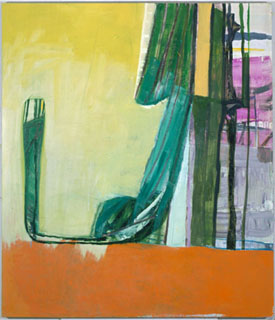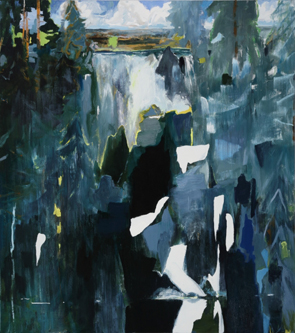The Afterlife of Painting
John Haberin New York City
Amy Sillman, Julian Schnabel, and Robert Mangold
Eric Aho and Cecily Brown
If painting is dead, as critics used to say, it is having quite an afterlife. But what brought it back—and when?
It takes a stubborn spirit to ask amid such abundance. In mid-fall alone, galleries offer African American abstraction and persistent women, as I describe elsewhere. They also highlight three answers to that "when," with Amy Sillman, Julian Schnabel, and Robert Mangold.  Meanwhile Eric Aho embraces sensation, in New England's turbulent waters and frigid winters. Last, Cecily Brown paints abundance itself, but with dead animals. But what has brought abundance back in style?
Meanwhile Eric Aho embraces sensation, in New England's turbulent waters and frigid winters. Last, Cecily Brown paints abundance itself, but with dead animals. But what has brought abundance back in style?
From rebellion to old master
A cynic might answer with a shrug: contemporary art became big money. No question either but collectors require something to collect like, say, painting—and a wider audience for art, beyond the elite and the underground, is more willing to seek out pleasure. To declare that painting is dead, you had to be pretty suspicious of money and pleasure in the first place. Come to think of it, that was actually a strength of Postmodernism devoted to politics and "theory." Yet it also turned on the collision of art and ideas—and that left room all along for painting.
They keep colliding, too, like distant worlds for Jordan Kasey and near abstract bodies for Linda Matalon, Grace Carney, or David Humphrey. One collision came when painters no longer felt the burden of an ultimate standard for painting, whether formalism on the one hand or skilled realism on the other. Now anything goes, and a harbinger was Amy Sillman. Or look back further, to what seemed at the time not a revival of painting but rebellions against it. Neo-Expressionism in the late 1970s could revive gesture but only by turning painting literally upside down with Georg Baselitz—and, with Julian Schnabel, with broken dinner plates. Before that, Minimalists like Robert Mangold meant to take subjectivity out of painting, but a top-tier gallery displays him, too, as a model for painting.
This site has devoted its share of words to the perils of art and money. Yet I began in the unfashionable 1990s, seeking pleasure in painting as far off as Staten Island. It took a new century to bring pleasure into the mainstream—as what a 2006 work by Sillman called The Elephant in the Room. Images could slip in and out of view and in and out of abstraction. Flat surfaces could suggest collage even when they did not incorporate mixed media. Now Sillman discards her chalk-like line and comes down hard in favor of paint.
The results are lusher than ever. Her abstractions run to broad gestures on wide-open grounds. They look like nothing so much as late Willem de Kooning. Of course, by then he was losing it, and Sillman takes the easy way out, too, with flowers. She seems more at home with guilty pleasures than with puzzles. Smaller versions hang densely as introduction to the wholewhole—or as a lesson in someone's academic standards.
Neo-Expressionism was always prone to temper tantrums, at least the good old American kind. Where Italy had pleasing fantasies and Germany its somber history lessons, Schnabel had his broken plates. He distrusted art enough, in fact, to abandon even that for the movies. Now he is painting again, with what could pass, like big reds by Alix Le Méléder, for a single brushstroke set against earth and sky. Works look back to a Surrealist source for Abstract Expressionism in Joan Miró. Some stretch at the corners like sheets fresh off the line, and a title asks to Let the Wind Speak.
Mangold has space (upstairs from Jean Dubuffet) in the same gallery's flagship building up the street. It makes his new work look all the larger, brighter, and ready to leap off the wall. He conjoins rectangles for his own sense of activity, color, composition, and shaped canvas. He shares the conjunction with Ellsworth Kelly—and, with Donald Judd, the ability to make materials soak up room lights as if lit from within. Schnabel calls another painting Sad Lament of the Brave, but this is not the occasion for sadness. If all three artists have lost something as putative old masters, a woman included, they began in genuine rebellion.
Luxuriance and chill
Eric Aho lends landscape a singular luxuriance. By the show's closing, it will have become the unrelenting face of winter. Aho thinks of New England both ways, just as he thinks of painting. He sees himself, he says, in the company of writers who cannot hold back a word of what they feel or observe, from Walt Whitman to John McPhee—you know, those twelve-part New Yorker articles on sand.  Well, I exaggerate, but he does speak of a naturalist's seeking, searching, and roaming. He must know, too, that words for all their honesty can take on a life of their own.
Well, I exaggerate, but he does speak of a naturalist's seeking, searching, and roaming. He must know, too, that words for all their honesty can take on a life of their own.
It may take a moment even to see his art as landscape—and just what counts as what the exhibition title calls his "Source"? His deep, textured patchwork of color has a parallel in Clyfford Still, but without the darkness and claustrophobia of Bay Area painters after World War II. A canvas can stand more than seven feet tall, in the manner of epic abstraction, with brushwork to match. Aho, though, also sees himself in dialogue with artists who could still reconcile frankness and Romanticism, from John Constable to Winslow Homer. He may think of Constable's cloud studies in the same breath as Homer's raging seas. He makes it a challenge to see the sky for the water, while retaining the imprint of sunlight.
It turns up as a bright yellow outline on back-lit rocks and trees. He has plenty of both, in evergreen mountains. He can have a fiery orange and red as well, from sunsets, soil, and autumn leaves. Still, Aho prefers blue, in a range of shades for rivers, skies, and trees in the winter air. The more time one spends with them, the more white takes over everything, too. Vermont, I am afraid, is cold.
If the show's arc is from nature's luxuriance to chill, it does not come just by watching and waiting. Landscape still has its contemplative side, as does abstraction. Abstract Expressionism helped create new audiences for the vast open spaces of Thomas Cole and the Hudson River School. Yet they also have their immersive side, and Aho puts one in the thick of things. No wonder I grew so cold. He pretty much has no open spaces.
The disorientation and affinity to abstraction depend on how things press in. What I took in one painting to be the horizon line common to some abstract artists as well, like Virginia Jaramillo, turned out to be a lakeside. The lack of time and distance for contemplation also arises from water in motion. It includes a waterfall and rapids. The churning waters add to the white as well. Aho arranges a series of smaller paintings, just fourteen inches tall, in a close row. They could almost be a single stop-action record.
He works fast, simply to keep up with the action. It is harder to recall individual paintings than the overall impression. For all that, though, he is in it for the long haul of changing skies and seasons. Just when I was ready to dismiss the painting as comfortable and glib, I could appreciate the particulars. I came to admire most the fire and ice. Robert Frost did say that the world could end in either one.
Dead Meat
After more than twenty years playing bad girl, Cecily Brown aspires to an old master, too. She has every right, just as her past work was a rebuke to untold bad boys in contemporary art—leering, showing off their toys, and strutting their stuff. Besides, she was confronting art history all along. Her pink, fleshy nudes spreading their crotch take on past models from Titian on down and from Venus to the brothel. They just happen to expose the private parts that men might have kept constrained or implicit. Now, though, Brown trades her women for actual dead meat.
Not that it no longer speaks to its metaphoric equivalent in gendered longings and self-assertion, for all my fears of a new academicism. She makes that much clear in calling a triptych One Man's Meat. It also makes clear that she has not lost her sense of humor or her pretty poison. She does, though, fill up to five canvases across with dead birds and pillage from the hunt, amid her usual lushness in paint alone. She is also out to top an official old master, Frans Snyders. She quotes his still lifes while throwing his compositions to the wind.
She still has her share of women, but one may have to look harder to spot them—much as with women half buried in late photos by Cindy Sherman. She also has something more obviously fictitious or confessional, if only one could decide which. Hints of interiors structure what she calls her "bedroom paintings," and the walls press in on their disorder. Here, too, an apparent pleasure and excess compete with a felt sadness or claustrophobia. They may also continue her competition with older art. The gallery quotes an art historian who sees echoes of Symbolism and James Ensor.
The competing sensations may help explain her turn to the Baroque, when dead animals promised both a hearty meal and intimations of mortality. It may also explain her interest in a Flemish painter rather than the Dutch, with their depth of contemplation and of natural light. The Flemish, like Snyder, prefer darker and shinier colors, for the luxuriance of porcelain or enamel, but also the discomfort. They, unlike the Dutch, had not so much as tried to throw off the rule of Spain or the high church. They knew their place, but also their loss of innocence. In her still lifes, Brown allows herself an intrusion of richer colors amid the pink as well.
Beatrice Caracciolo, at the gallery's second space a few blocks away, sounds more innocent with her Innocenti. It refers, though to the Biblical massacre of the innocents, and she, too, quotes the seventeenth century. She indulges in the modern English sense of "baroque" as well, as a mess. She thinks of her drawing in black and white as the expressive outlines of a relatively minor Italian, Francesco Trevisani. The whole idea of a diagram of a past master recalls a half forgotten way of teaching art. Back then, abstraction ruled, and it governed past and present.
Brown is sharper, and "bedroom paintings" could well sum up her entire work. She can be close to abstraction or skilled in her rendering of women, original or art historical, pleasurable or defiant. It depends less on which work of hers is at hand than the viewer. One also has to look hard to know—although a sketch at the Drawing Center, in a show of drawings after Covid-19, makes Snyders easier to see. Young artists often take older models as a given while confident that they can outdo them. Brown retains some of that adolescent spirit, but on a larger scale and in a more knowing art.

Amy Sillman ran at Gladstone through November 14, 2020, Julian Schnabel at Pace through October 24, Robert Mangold there through November 14, Eric Aho at D. C. Moore November 7, Cecily Brown at Paula Cooper through November 21, and Beatrice Caracciolo there through October 17.




